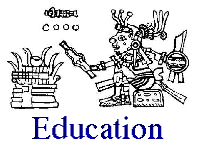|
|

Children were promised to schools when they were still infants, but the formal entrance and presentation did not take place until they were of age. Both the promising and the actual entrance ceremonies were marked by lengthy speeches, in which the children were urged to obedience, deportment, diligence, humility, self-discipline, humility, self-discipline, and cleanliness. There were two types of school, neither of which was co-educational. The first type of school was the telpochcalli, "youth house." These schools were for religious training, knowledge of history, ritual dancing and singing, as well as rhetoric. Boys entering the telpochcalli would be given military training, while girls would learn to participate in the religious cults they would serve in later life.
The second school was known as the calmecac. Its purpose was to train the most promising boys and girls from the nobility for leadership in religious, military, or political life. Discipline was strict, obedience was enforced, and students underwent periods of rigorous abstinance with penances, prayers, and ritual baths. The atmosphere was like that of a military academy or monastery. The curriculum included basic calendrical calculation and the use of the tonalamatl. The significance and timing of the veintena festivals were taught, and students were expected to learn a range of ritual performance and how to address the deities. History, arithmetic, architecture, astronomy, agriculture, and warfare were also part of the curriculum.
The art of speaking was interwoven with the teaching of all these subjects, because the learning of technical skills, accounts of history, the reciting of stories and poetry, the conduct of lawsuits, and bargaining, were all primarily accomplished through oral means. To be educated in Aztec society was to be a master of expression and an orator. An educated person had to be able to deliver artful and moving speeches on a diversity of occasions with all the etiquette prescribed by the highly formalized pattern of Aztec life. Memorization played a crucial role in the oral method of learning. It was facilitated by repetitive rhythms and the percussive beat of musical instruments as well as by the meter and cadence of poetry and song.
There were no books in the sense of today's textbooks, no manuals, no histories or novels. Aztec hieroglyphic writing had a restricted field, where individual glyphs appear embedded in large pictorial compositions, communicating names, places, dates, and tallies.
|
|

